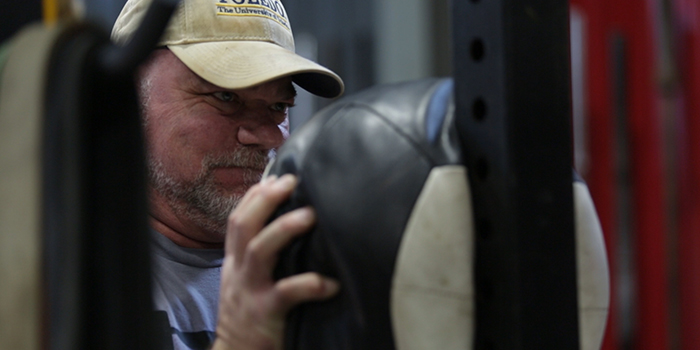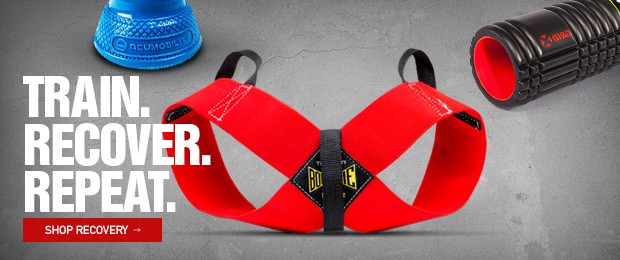
Editor's Note: Fixing Dave Tate is an educational video series intended for demonstration purposes only (acts as a case study specific to Dave Tate). It is not intended to medically diagnose, treat, or manage symptoms. If you are in pain, please consult a licensed healthcare professional.
In the previous installment of the Fixing Dave Tate series, Dr. Rusin detailed the six-phase dynamic warm-up sequences designed to help Dave rebuild his foundational movements patterns and reduce his experience of pain during training and daily life. He explained the purpose of each of the six components and outlined how they will be used to accomplish Dave's goals. In these next two videos, Dr. Rusin explains each of these two warm-up sequences in further detail, coaching Dave through each movement and providing commentary on why each part is so important. Together they perform each movement from both the upper body sequence and the lower body sequences.
Upper Body Dynamic Warm-Up Sequence
Dave and Dr. Rusin first go through the upper body warm-up sequence, including the following movements and guidelines to be performed prior to each upper body training day:
1. Three-Way Thoracic Spine Foam Roll
This is performed in three ways: extension-based, flexion-based, and with a diaphragmatic breathing focus. Dr. Rusin demonstrates the proper area to place the foam roller and how to perform each of the three spine rolling techniques. There is very little relative motion, with oscillation only on the key segments. The extension portion focuses on joint extension, the flexion portion focuses on soft tissue quality, and the breathing portion focuses on active bodily control.
2. Single-Arm Internal Rotation/External Rotation Active Pec Stretch
This movement is used for reciprocal inhibition with high-tension based stretching without stressing Dave's glenohumeral joint. In a 90-90 elevated position and the "stretching" hand and forearm stabilized against the rack, the opposite hand should put pressure on the pec and palpate while rotating internally and externally at the shoulder. To achieve this rotation, the body should move while the arm does not.
3. Quadruped Thoracic Spine Rotation
In a quadruped position, this exercise is performed by first stabilizing the shoulders, hips, and core. With one arm's fingertips on the back of the head, rotate the shoulder by turning the elbow toward the ground and then up toward the air. Hold at the top of the range of motion while also forcing a strong exhale. Perform both sides.
4. Band Pull Down and Apart
With greater range of motion opened up through thoracic spine mobility, this part of the upper body sequence is intended to help add stability to that region of the body. To activate the upper back for this purpose, the band is attached to the top of a squat rack and the hands are placed palms-down within the band. Dr. Rusin explains that the first move is pulling down and then, while keeping the tension, pulling apart the band and flexing as hard as possible. The lats should stay engaged the entire time.
5. Hands Elevated Push-Up
For this exercise, Dr. Rusin explains that Dave will perform a closed-chained horizontal press. Great care must be taken to keep constant tension on the stabilizers while performing this movement. To achieve this, Dr. Rusin has Dave begin on his knees with his hands on the bench and then move his legs back one at a time. The focus should then be on controlling the eccentric portion of each rep.
6. Slam Ball Overcoming Iso Press
Central nervous system stimulation is the final part of Dave's six-phase upper body dynamic warm-up sequence. Dr. Rusin demonstrates this movement by holding a ball against a rack with the top of the ball in alignment with his chin and his hands on the midline of the ball. In a split stance and with a strong controlled core, push as hard as possible into the rack for five full seconds. The idea is to build as much tension in the entire body as possible.
By the minute:
- (0:51) Three-Way Thoracic Spine Foam Roll
- (5:03) Single-Arm Internal Rotation/External Rotation Active Pec Stretch
- (6:45) Quadruped Thoracic Spine Rotation
- (9:30) Band Pull Down and Apart
- (11:43) Hands Elevated Push-Up
- (13:32) Slam Ball Overcoming Iso Press
- (14:36) Reviewing progress and planning next steps
Lower Body Dynamic Warm-Up Sequence
The lower body dynamic warm-up sequence also includes six unique movements to be performed before each lower body training session, in the following order:
1. Rectus Femoris (Mid-Quadriceps) Foam Roll
The rectus femoris goes directly down the midline of the quad, attaching across the knee and the hips. This makes it a key player for Dave's improvement. Focusing on one leg at a time, everything in the body stays neutral with the knee slightly bent into flexion. Dr. Rusin explains to again use the oscillation technique and make the goal to find several trigger points and stay on them.
2. Half-Kneeling Hip Flexor Positional Stretch
This posturally-dependent position is used to stretch the knee and, performed properly, requires Dave to turn on tension one bodily segment at a time. Dr. Rusin explains how to use a top-down approach and shows Dave in which order to create tension so the stretch-based response occurs at the hip flexor.
3. Quadruped Arm-Leg Opposites (Bird Dog)
This corrective exercise is performed in a quadruped position with tension throughout the body. With a neutral spine position and bracing at the core, Dr. Rusin explains that the goal is to extend opposite arm and legs with tension throughout the body. The key is to focus on smoothness, sequencing, and stability. The harder the contraction at the top, the better.
4. Banded Glute Bridge
This is a simple setup that can be performed anywhere. The banded glute bridge needs two bands: one between the knees and one looped from one foot, around the waist, and then around the other foot. With the bands in place, drive the knees out and externally rotate the hips to maximize pre-tension. Then brace the scapula, pull the knees apart, brace the core, and raise up as hard as you can. As Dr. Rusin walks Dave through this movement, he notes that you want to position your feet so that the contraction occurs in the glutes rather than the hamstrings or lower back. Release everything at the bottom of each rep to reset.
5. Sumo Dumbbell Squat and Dumbbell Romanian Deadlift
This superset functions as the lower body foundational movement pattern development phase of the sequence. Dr. Rusin explains that, using a light load, this will help Dave work on mobility and stability simultaneously, and will tie-in to his main training movements. Before descending on the dumbbell squat, Dr. Rusin tells Dave to focus on centering the hips by using pre-activation and pre-tension of the lateral posterior chain. For the Romanian deadlift, the key is to feed the dumbbell through the heels with a neutral spinal position, using the lats in conjunction with the glutes and hamstrings to prime the entire posterior chain. The focus isn't to increase the weight or the range of motion but to connect the upper body and lower body.
6. Split Squat Midrange Iso-Hold
As the final movement of the lower body dynamic warm-up sequence, this iso-hold is a joint-friendly way to bring the posterior and anterior chain together while bracing at the core. Dr. Rusin explains that, in the setup, you're looking for a position close to 90-90 with a hard squeeze at the midrange of motion.
By the minute:
- (0:50) Rectus Femoris (Mid-Quadriceps) Foam Roll
- (2:25) Half-Kneeling Hip Flexor Positional Stretch
- (5:06) Quadruped Arm-Leg Opposites (Bird Dog)
- (7:59) Banded Glute Bridge
- (11:34) Sumo Dumbbell Squat
- (13:31) Dumbbell Romanian Deadlift
- (15:37) Split Squat Midrange Iso-Hold
FIXING DAVE TATE SERIES
- Initial Assessment with Dr. John Rusin
- Movement Screening
- Orthopedic Evaluation
- The Three Areas of Focus Discovered During Initial Evaluation
- Observing Dave's Current Training Capabilities
- Programming the Six-Phase Dynamic Warm-up Sequence
- The Dynamic Warm-Up Sequences for Upper Body and Lower Body









